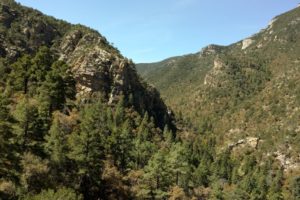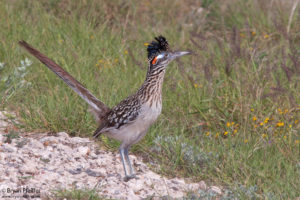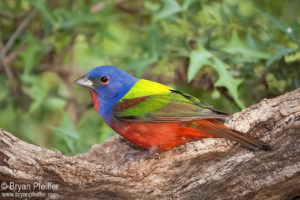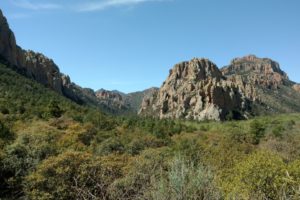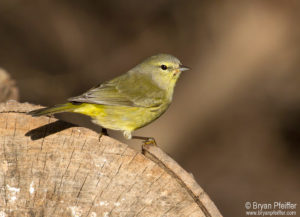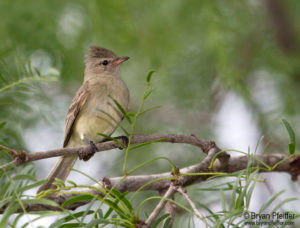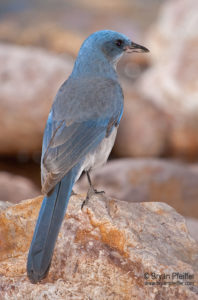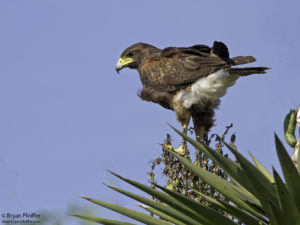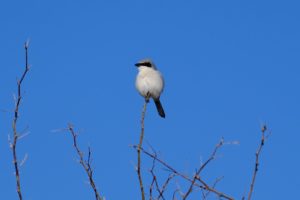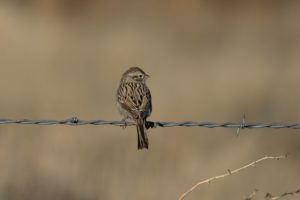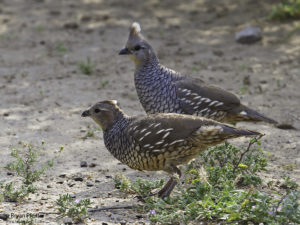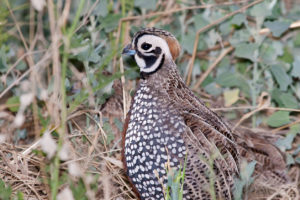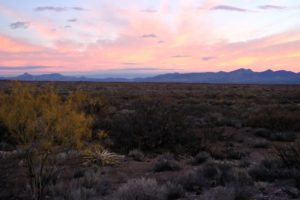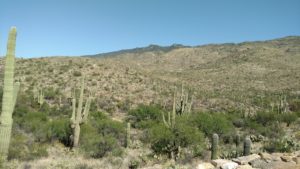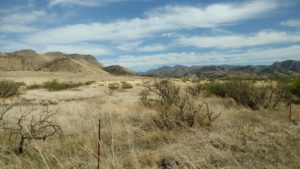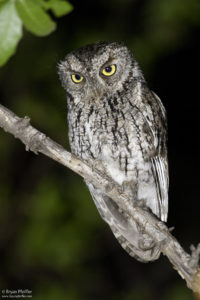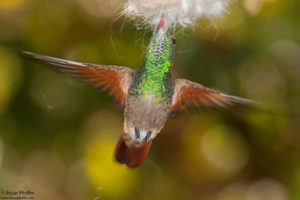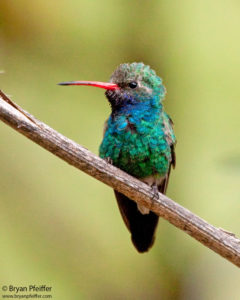Birding Arizona

The Sky Islands of the Southwest
April 19 - 27, 2025
Price: $3200 ($500 deposit upon registration)
Single Supplement: $450
Magical, high-elevation "Sky Island" mountain ranges rise thousands of feet above the desert floor of Southeastern Arizona. Here, Roadrunners and Vermillion Flycatchers dart among saguaro cacti and mesquite thickets in the low foothills, while Elegant Trogans and brilliant hummingbirds adorn the branches of a subtropical montane forests above.
This trip loops through Portal, Arizona, the gateway to the famed Chiricahua Mountains, then continues through the Huachuca Mountains and Madera Canyon. Along the way, we'll experience diverse ecosystems from the Sonoran Desert to the sycamore-lined creeks of Ramsey Canyon.
Elegant Trogon, Red-faced Warbler, Painted Redstart and a host of hummingbirds (Blue-throated Mountain-gem, Lucifer, Violet-crowned and more) enliven the beautiful landscape of the sky islands. Spring migrants will also be passing through the region, adding birds like Hermit Warbler and Lazuli Bunting to the mix. And you never know what will show up in Southeast Arizona: Ruddy Ground-Dove, Rufous-backed Robin, Golden-crowned Warbler have all been seen this year, but there are sure to be surprises in store as well!
This flexible itinerary will include renowned lodges and classic birding destinations such as Cave Creek Ranch, Ash Canyon Bird Sanctuary, Ramsey Canyon, Madera Canyon, San Pedro River, Rustler Park, Saguaro National Park, and more.
Additional Information
Flow of the Day: The itinerary is designed to maximize our experience with the region's great diversity of birdlife and ecosystems. We won’t, however, be rushing from place to place to chase the largest species list possible. Our goal is to spend time appreciating the species we encounter at an enjoyable pace. Birding walks begin in the early morning, and we travel slowly to allow for the best bird and wildlife encounters and observation.
Afternoon plans may allow for some rest time at the lodges, though this is not always feasible when we are transferring between lodges or birding far from the lodge on a given day.
Clothing: Pack light field clothing of neutral colors. Bring several pairs of long pants and comfortable, light, airy shirts. Long-sleeved (relaxed fit) shirts are useful for protection from the sun, as is a light hat or cap. Be sure to have a pair of comfortable walking shoes or hiking boots, plus a second pair of tennis shoes or sandals. A sweater, a hat, and gloves are important for our higher elevation areas where it can be cold in April.
Equipment: Bring a pair of binoculars, a field guide and a camera with extra batteries. Your guide will carry spotting scopes. Pack sunglasses and sunscreen, a small flashlight or headlamp, a small alarm clock (a smartphone will work), insect repellent, a small daypack, and a small folding stool if you get tired standing for long periods waiting for birds.
Physical Expectations: Much of the birding on this trip will be along roadsides or easily walked trails, but do expect some hilly and uneven conditions. Participants should be able to hike on moderate terrain up to 2 miles per day, and be ready to expect conditions that may be hot, cold, dry, wet, or anything in-between.
Transportation: We will be travelling in Arizona in a 15-passenger van. Trip capacity is limited for traveling comfortably in our vehicle.
Accommodations: All of the lodges where we’ll be staying are situated in or near ecological reserves. They are chosen for strategic access to great birding, rather than for the bells and whistles that come with more luxury resorts. That said, all lodges are clean and comfortable, and often allow for excellent birding right at the hotel property.
Meals: We'll have a hot meal each night for dinner at the lodge or in town. Breakfasts and lunches will be a combination of sit-down meals and picnics, depending on where we are. Like our accommodations, our dining arrangements are selected to have filling, tasty meals without spending our peak birding times sitting inside restaurants.
Chip Darmstadt, Birding Ambassador and "emeritus" executive director of North Branch Nature Center, is an avid neotropical birder and naturalist. Chip has guided birding trips around the US and around the world for 25 years, observing over 2,300 bird species along the way.
What’s included:
- All lodging and meals.
- All ground transportation throughout the trip.
- Expert naturalist guide.
- Any entrance fees and park admissions.
- Use of high-quality shared spotting scopes.
- Pre-departure orientation session before the trip.
What is not included:
- Airfare and transportation to arrival hotel.
- gratuities.
- pre-trip expenses.
- incidentals such as alcohol and souveniers.
Here is an eBird list of all species seen in Southeastern Arizona in April over the last 10 years. The frequency bar charts will help give you an idea of how regularly each species is seen.
NBNC is proud to announce that all of our trips from 2025 onward are 100% carbon-neutral. This includes each traveler's flights to and from this destination, as well as carbon emitted during the trip.
How it Works: The voluntary carbon market has come under intense scrutiny in recent years as the legitimacy and effectiveness of many carbon offsetting projects have been called into question. That's why we're proud to be working directly with the Northeast Wilderness Trust's Wild Carbon program. The carbon credits we purchase to offset our carbon emissions are used to permanently conserve forestland as wilderness. Why wilderness offsets?
- It's Permanent: Unlike most contracts in the voluntary carbon market that have a lifespan of just 10-20 years, wilderness conservation is forever.
- It's Additive: Acreage purchased and conserved through wild carbon offsets would not be protected anyway through another mechanism later.
- It's "Leakproof:" Forest protection often just shifts and concentrates timber harvest elsewhere. But wilderness conservation is different–wilderness protection here doesn't just move carbon emission over there. That's because old forests function very differently than young ones. Big trees and old soils capture and store vastly more carbon than a young forest of the same acreage. Growing an old forest is like building a natural carbon sequestration factory!
- It's More than Carbon: With wilderness protection comes additional co-benefits like biodiversity conservation, flood resilience, and habitat connectivity. This way, going carbon-neutral isn't just negating our carbon footprint, it's also actively helping conservation in other ways.
Want to learn more?:
- Read The Ecotourism Dilemma our article on how we think about carbon emissions in the context of nature travel.
- Check out this FAQ for NBNC travelers about Northeast Wilderness Trust's Wild Carbon Program.
- To learn more about forest carbon storage, please watch Understanding Forest Carbon by climate forester Dr. Ali Kosiba.
Ready to go to Arizona?
Email [email protected] to get signed up.
Payment Schedule
- A $500 deposit is required to reserve your space on the trip.
- 50% of the trip balance will be due 6 months before the departure date.
- The remaining trip balance will be due 3 months before the departure date.
All payments can be made via ACH withdrawal, or by check. Credit card payments will incur a 3% surcharge.
Cancellation Policies
We understand that incidents and emergencies arise that may force you to cancel your trip. However, NBNC invests considerable time and, in many cases, non-refundable payments to lodges and local contractors to secure our rooms and programming. NBNC aims to be as flexible as possible in our refund policy, but a full refund of your payments may not be possible after the dates indicated. All cancellations must be made via email to NBNC.
-
Cancellation more than 180 days before the trip: Full refund of all payments.
-
Cancellation 90-180 days before the trip: Refund of any payments minus the $500 deposit. If your space is filled by another traveler, we will also refund your deposit.
-
Cancellation 30-90 days before the trip: No refund guaranteed. If your space is filled by another traveler, we will provide a full refund minus the $500 deposit.
-
Cancellation less than 30 days before the trip: No refunds guaranteed.
We highly recommend purchasing private travel insurance to cover expenses that are outside of NBNC's cancellation and refund policies.
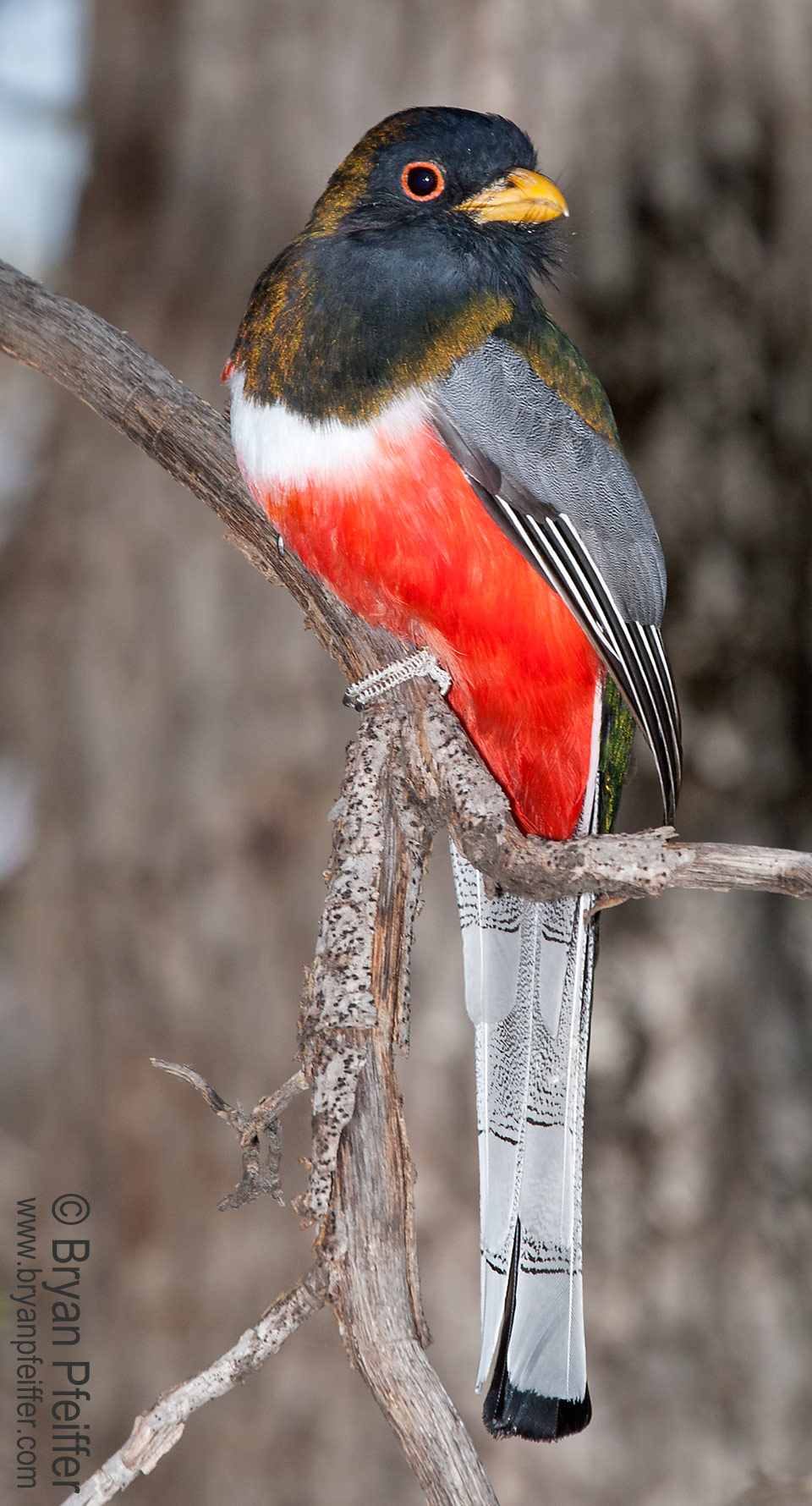
Day by Day Itinerary
Day 1 (April 19): We’ll meet at 6pm at our hotel in Tucson for a welcome and orientation dinner. We’ll have the chance to get to know one another and talk about the week of birding to come. If you arrive early, and are eager to start birding, Reid Park is conveniently located across the street! A shuttle is available from the airport to our hotel. Overnight Tucson (DoubleTree Inn or comparable).
Day 2 (April 20) – Tucson: We depart the hotel early this morning in search of notable birds of the Tucson area. Depending on what has been seen locally, we’ll either start the day at Sweetwater Wetlands or Saguaro National Park or other local birding hotspot. We’ll then bird our way to Portal, where we’ll be based for the next three nights. Portal is tucked into the Chiricahua Mountains, one of the sky islands of southeastern Arizona. Our lodging in Portal is at the beautiful Cave Creek Ranch, a lovely setting and renowned birding destination that we’ll find difficult to leave! Overnight Portal (Cave Creek Ranch).
Day 3 (April 21) – Explore Portal: This morning we head straight to Cave Creek in search of Painted Redstart, Dusky-capped Flycatcher, Arizona Woodpecker, Blue-throated Mountain-gem and Hepatic Tanager. With some luck we may even find Elegant Trogon. Later in the afternoon we’ll look for desert-loving thrashers (Bendire’s and Crissal), crossing into neighboring New Mexico. The nearby Willow Tank birding hotspot will hopefully yield some water-loving species such as Mexican Duck. Overnight Portal (Cave Creek Ranch).
Day 4 (April 22) – Explore Portal: Today we’ll focus on the birds found at higher elevations near Portal including Yellow-eyed Junco, Olive Warbler and Pygmy Nuthatch. The Chiricahua Mountains are the only reliable place in the United States to find the Mexican Chickadee, which we’ll search for on our way up to Rustler Park. We’ll stay out until nightfall, owling our way back to the ranch. Flammulated, Whiskered and Western Screech-Owls are all residents of this area. Overnight Portal (Cave Creek Ranch).
Day 5 (April 23) – Portal and the Huachuca Mountains: We’ll get an early start for our morning drive to Sierra Vista, stopping in Bisbee for lunch. Birding stops along the way may include the San Pedro River and Coronado National Monument. The San Pedro River, with its lush riparian vegetation, is a vital refuge for many species, including Gray Hawk, Green Kingfisher (rare), Yellow-breasted Chat and Yellow-billed Cuckoo. Overnight Sierra Vista (Sierra Suites Hotel).
Day 6 (April 24) – Ramsey Canyon: Ramsey Canyon, a Nature Conservancy preserve in the Huachuca Mountains, is a delightful and birdy place to explore. The diverse habitats of Ramsey Canyon and adjacent Miller Peak Wilderness are home to Grace’s and Red-faced Warblers, Painted Redstart, Greater Pewee, and Hutton’s Vireo. We might even get lucky and stumble upon a Spotted Owl or a covey of Montezuma Quail. Depending on what other Arizona specialties are being reported, we can check out other nearby canyons including Ash and/or Miller Canyon. Overnight Sierra Vista (Sierra Suites Hotel)
Day 7 (April 25) – Ash, Miller, and Madera Canyon: After a morning walk in Miller Canyon or a visit to some local hummingbird feeders, we’ll take the long way around to Madera Canyon in the Santa Rita Mountains. We’ll explore some birding hotspots on the way, including Paton Center for Hummingbirds where we’ll look for Violet-crowned Hummingbird, Abert’s Towhee and Lazuli Bunting. Nearby locales in Patagonia might host nesting Rose-throated Becard (also possible in Tubuc area), as well as Bell’s Vireo, Northern Beardless-Tyrranulet and a host of northbound migrants. We’ll want to have time to settle in at our last lodge of the trip in Madera Canyon. At dusk we’ll head across the street to hopefully witness Elf Owls emerge from their roost in a telephone pole! An owling expedition tonight or tomorrow may also yield Whiskered Screech-Owl and Mexican Whip-poor-will. Overnight Madera Canyon (Santa Rita Lodge).
Day 8 (April 26) – Madera Canyon: Our last full day of birding will be a great one! The cool forests of this famous birding destination are home to Elegant Trogon, Northern Pygmy-Owl, Flame-colored Tanager and so much more. The feeders at Santa Rita Lodge attract up to 8 species of hummingbird in the spring, including Rivoli’s, Broad-tailed, Black-chinned. Calliope, Broad-billed, Anna’s, Rufous and Costa’s Hummingbirds. Lower in elevation in the desert scrub and grasslands we have a chance at finding the rare Black-capped Gnatcatcher, Montezuma Quail and Scott’s Oriole. Overnight Madera Canyon (Santa Rita Lodge).
Day 9 (April 27) – Return home: We’ll get an early start this morning, hopefully squeezing in some birding before we head to the airport. Nearby Proctor Road and Florida Canyon are great spots to look for lower elevation species like Rufous-winged and Black-throated Sparrow, Black-tailed Gnatcatcher, Verdin and occasionally Rufous-capped Warbler. It will be tough to pull ourselves away as we head north to Tucson to catch our flights back home!

713 Elm Street
Montpelier, Vermont 05602
(802) 229-6206
Hours: Center Open Monday-Friday 9-4
Trails Open 24/7

